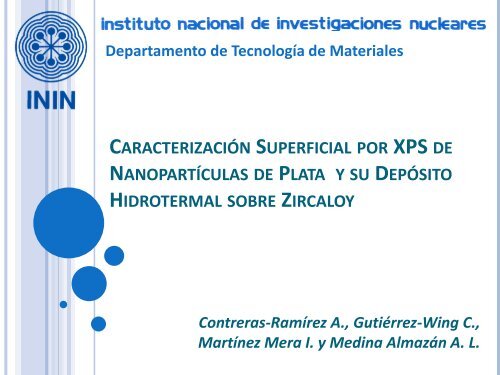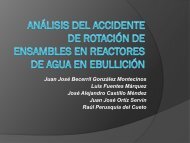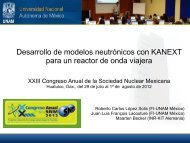Caracterización Superficial por XPS de Nanopartículas de Plata y su ...
Caracterización Superficial por XPS de Nanopartículas de Plata y su ...
Caracterización Superficial por XPS de Nanopartículas de Plata y su ...
Create successful ePaper yourself
Turn your PDF publications into a flip-book with our unique Google optimized e-Paper software.
Departamento <strong>de</strong> Tecnología <strong>de</strong> Materiales<br />
CARACTERIZACIÓN SUPERFICIAL POR <strong>XPS</strong> DE<br />
NANOPARTÍCULAS DE PLATA Y SU DEPÓSITO<br />
HIDROTERMAL SOBRE ZIRCALOY<br />
Contreras-Ramírez A., Gutiérrez-Wing C.,<br />
Martínez Mera I. y Medina Almazán A. L.
SECUENCIA<br />
Introducción<br />
Técnicas analíticas empleadas<br />
Materiales BWR<br />
Técnicas <strong>de</strong> mitigación <strong>de</strong> corrosión<br />
Metales nobles<br />
Objetivo<br />
Método<br />
Preparación <strong>de</strong> probetas<br />
Síntesis <strong>de</strong> nanopartículas<br />
Re<strong>su</strong>ltados<br />
DRX<br />
<strong>XPS</strong><br />
Conclusiones<br />
Recomendaciones<br />
2
PRINCIPIO DE <strong>XPS</strong><br />
INTRODUCCIÓN<br />
•Los rayos X <strong>de</strong> una fuente <strong>de</strong><br />
fotones inci<strong>de</strong>n sobre la <strong>su</strong>perficie.<br />
•En consecuencia algunos electrones<br />
son expulsados.<br />
•La energía cinética (KE) <strong>de</strong> los<br />
electrones se mi<strong>de</strong> mediante un<br />
analizador.<br />
•La energía <strong>de</strong> enlace se calcula:<br />
BE = hn - KE<br />
Energía <strong>de</strong> enlace <strong>de</strong>pen<strong>de</strong> <strong>de</strong>:<br />
El elemento.<br />
El orbital <strong>de</strong> electrones <strong>de</strong> la que es expulsado.<br />
La química <strong>de</strong>l estado <strong>de</strong>l elemento.<br />
3
PRINCIPIO DE <strong>XPS</strong><br />
INTRODUCCIÓN<br />
Espectroscopía fotoelectrónica <strong>de</strong> rayos X (<strong>XPS</strong>)<br />
20-30 Å<br />
4
MATERIALES BWR<br />
INTRODUCCIÓN<br />
Las aleaciones <strong>de</strong> circonio (Zr) fueron<br />
<strong>de</strong>sarrolladas para obtener mejores propieda<strong>de</strong>s<br />
mecánicas y resistencia a la corrosión.<br />
Entre los principales elementos <strong>de</strong> aleación se<br />
encuentran: Estaño, Hierro, Cromo y Níquel.<br />
En la industria nuclear se emplean generalmente<br />
dos tipos <strong>de</strong> aleaciones, zircaloy-2 y zircaloy-4.<br />
5
INTRODUCCIÓN<br />
La vasija y partes internas <strong>de</strong> los reactores BWR<br />
son <strong>de</strong> acero inoxidable austenítico 304 (304 SS).<br />
TÉCNICAS DE MITIGACIÓN<br />
Con el objetivo <strong>de</strong> mitigar la velocidad <strong>de</strong><br />
crecimiento <strong>de</strong> grieta <strong>por</strong> corrosión intergranular<br />
bajo esfuerzo (IGSCC) a un impacto negativo<br />
mínimo.<br />
GE® propuso <strong>de</strong>positar partículas <strong>de</strong> metales<br />
nobles, como Pt, Pd y Rh, sobre la <strong>su</strong>perficie <strong>de</strong>l<br />
304 SS para catalizar la recombinación <strong>de</strong> H 2 y O 2.<br />
Al mismo tiempo se inyecta hidrógeno para tener<br />
un exceso <strong>de</strong> éste y favorecer esta recombinación<br />
con el oxígeno, lo que se conoce como química <strong>de</strong><br />
agua con hidrógeno (HWC, <strong>por</strong> <strong>su</strong>s siglas en<br />
inglés).<br />
6
METALES NOBLES<br />
INTRODUCCIÓN<br />
En el <strong>de</strong>pto. <strong>de</strong> Tecnología <strong>de</strong> Materiales <strong>de</strong>l Instituto<br />
Nacional <strong>de</strong> Investigaciones Nucleares (ININ), se sintetizan<br />
nanopartículas <strong>de</strong> plata, que <strong>por</strong> <strong>su</strong> tamaño y morfología<br />
presentan propieda<strong>de</strong>s diferentes a la plata común.<br />
En el mismo grupo <strong>de</strong> trabajo se propone estudiar el<br />
<strong>de</strong>pósito <strong>de</strong> palta sobre 304 SS y zircaloy.<br />
7
OBJETIVO<br />
Estudiar la <strong>su</strong>perficie <strong>de</strong> tubos <strong>de</strong>:<br />
Zircaloy (Zry).<br />
Zircaloy oxidado (Zry-Ox) bajo condiciones similares a las<br />
<strong>de</strong> un reactor tipo BWR .<br />
Zircaloy oxidado con un <strong>de</strong>positó hidrotermal <strong>de</strong><br />
nanopartículas <strong>de</strong> plata y cinc (Zry-Ox-Ag).<br />
8
ZIRCALOY<br />
MÉTODO<br />
Se seccionó tubo <strong>de</strong> Zry con una altura <strong>de</strong> 1 cm, estos a <strong>su</strong> vez<br />
se cortaron transversalmente, obteniendo cuatro probetas<br />
laminares <strong>de</strong> cada fragmento <strong>de</strong> tubo. Las probetas se<br />
oxidaron en una autoclave con agua a presión y temperatura<br />
durante quince días.<br />
Condiciones <strong>de</strong> Oxidación<br />
Presión 8.07 MPa<br />
Temperatura 287.22 °C<br />
Conductividad 0.06 mS/cm<br />
Oxígeno 950 ppb<br />
Hidrógeno 1.13 ppb<br />
pH 3.88<br />
9
ZIRCALOY<br />
MÉTODO<br />
Se utilizó el método hidrotermal para <strong>de</strong>positar las nanopartículas<br />
<strong>de</strong> plata y el cinc en la <strong>su</strong>perficie preoxidada <strong>de</strong> las probetas <strong>de</strong><br />
zircaloy (Zry-Ox).<br />
En contenedores <strong>de</strong> acero inoxidable se colocaron las probetas, con<br />
una <strong>su</strong>spensión <strong>de</strong> 1000 ppm <strong>de</strong> Ag-Cit y 1000 ppm <strong>de</strong> cinc,<br />
asegurando un cierre hermético.<br />
Se colocaron en una autoclave cubiertos <strong>de</strong> agua <strong>de</strong>sionizada a una<br />
temperatura <strong>de</strong> 150 °C durante 48 horas.<br />
10
RESULTADOS<br />
DIFRACTOGRAMAS<br />
Intensidad (U.A.)<br />
d)<br />
c)<br />
b)<br />
a)<br />
JCPDS 65-2871 Ag<br />
Ag-Cit<br />
Zry-Ox-Ag<br />
Zry-Ox<br />
JCPDS 65-3366 Zr<br />
Zry<br />
30 40 50 60 70 80<br />
2<br />
11
Transmitancia (U.A.)<br />
(a)<br />
(b)<br />
Ag-Cit<br />
Citrato<br />
RESULTADOS<br />
ESPECTRO INFRARROJO DEL CITRATO DE PLATA (Ag-Cit)<br />
3500 3000 2500 2000 1500 1000 500<br />
Numero <strong>de</strong> Onda (cm -1<br />
)<br />
12
Intensidad (U.A.)<br />
d)<br />
c)<br />
b)<br />
a)<br />
Ag-Cit<br />
Zry-Ox-Ag<br />
Zn 2p<br />
Zry-Ox<br />
Zry<br />
O KLL<br />
Ag 3s<br />
Fe 2p<br />
Ag 3p<br />
O 1s<br />
O 1s<br />
Zn LLM<br />
Zr 3s<br />
Ag 3d<br />
Ag 3d<br />
Zr 3p<br />
C 1s<br />
Zn 3s<br />
1000 800 600 400 200 0<br />
Energía <strong>de</strong> Enlace (eV)<br />
Ag 4d<br />
Ag 4p<br />
Ag 4s<br />
C 1s<br />
Zr 3d<br />
Zr 4p<br />
Zr 4s<br />
RESULTADOS<br />
ESPECTRO GENERAL <strong>XPS</strong> DE<br />
LA SUPERFICIE<br />
Elem.<br />
Zry<br />
% At.<br />
Zry-Ox<br />
% At.<br />
Zry-Ox-Ag<br />
% At.<br />
Ag-Cit<br />
% At.<br />
Zn 2p3 8,56<br />
Fe 2p3 3,49 1,09<br />
O 1s 68,68 80,31 60,37 17,22<br />
Ag 3d 1,95 39,46<br />
C 1s 43,32<br />
Zr 3d 31,32 16,20 28,03<br />
13
Intensidad (U.A.)<br />
Curva ajustada<br />
Línea base<br />
Zr 4+<br />
(Zr-OH)<br />
3d3/2<br />
3d3/2<br />
3d5/2<br />
Zr 4+<br />
(ZrO 2 )<br />
Zr 4+<br />
(ZrO 2 )<br />
3d5/2<br />
3d3/2<br />
Zr 0<br />
3d5/2<br />
ZrO 2<br />
188 186 184 182 180 178 176<br />
Energía <strong>de</strong> Enlace (eV)<br />
d)<br />
Zry-Ox-Ag<br />
c)<br />
Zry-Ox<br />
b)<br />
Zry<br />
a)<br />
Espectro<br />
a)<br />
Zry<br />
b)<br />
Zry-Ox<br />
c)<br />
Zry-Ox<br />
-Ag<br />
d)<br />
ZrO 2<br />
BE<br />
eV<br />
FWHM<br />
eV<br />
Área<br />
%<br />
Nivel Energét<br />
ico<br />
177.7<br />
179.9<br />
1.4<br />
1.4<br />
10.9<br />
3 d 5/2<br />
3 d 3/2<br />
181.6<br />
184.0<br />
1.4<br />
1.4<br />
89.1<br />
3 d 5/2<br />
3 d 3/2<br />
181.6<br />
184.0<br />
1.5<br />
1.5<br />
29.8<br />
3 d 5/2<br />
3 d 3/2<br />
183.02 1.5<br />
3 d 5/2<br />
70.2<br />
185.45 1.4 3 d 3/2<br />
181.6 1.4<br />
RESULTADOS<br />
ESPECTRO <strong>XPS</strong> DE ALTA<br />
RESOLUCIÓN Zr 3d<br />
3 d 5/2<br />
100.0<br />
184.0 1.3 3 d 3/2<br />
181.6 1.3<br />
3 d 5/2<br />
100.0<br />
184.0 1.3 3 d 3/2<br />
Estado Químico<br />
Zr °<br />
Zr 4+ , (ZrO 2)<br />
Zr 4+ , (ZrO 2)<br />
Zr-OH, Óxido<br />
s complejos<br />
Zr 4+ , (ZrO 2)<br />
Zr 4+ , (ZrO 2)<br />
14
Intensidad (U.A.)<br />
Curva ajustada<br />
Línea base<br />
O 2- Matriz<br />
O Puente<br />
O Terminal /-OH<br />
H 2 O Capas <strong>su</strong>periores<br />
ZrO 2<br />
536 534 532 530 528 526<br />
Energía <strong>de</strong> Enlace (eV)<br />
d)<br />
Zry-Ox-Ag<br />
c)<br />
Zry-Ox<br />
b)<br />
Zry<br />
a)<br />
Espectro<br />
a)<br />
Zry<br />
b)<br />
Zry-Ox<br />
c)<br />
Zry-Ox-Ag<br />
d)<br />
ZrO 2<br />
E. Enlace<br />
eV<br />
RESULTADOS<br />
ESPECTRO <strong>XPS</strong> DE ALTA<br />
RESOLUCIÓN O 1S<br />
FWHM<br />
eV<br />
Área<br />
%<br />
Edo Quím.<br />
532,6<br />
531,6<br />
2,1<br />
1,3<br />
13,4<br />
28,2<br />
H2O <strong>su</strong>perficial<br />
Oxígeno termin<br />
al<br />
530,7 1, 2 17,1<br />
Oxígeno puent<br />
e<br />
529,5 1,4 41,2 O2- , matriz<br />
533,1<br />
531,7<br />
2,5<br />
1,7<br />
42,8<br />
24,6<br />
H2O <strong>su</strong>perficial<br />
Oxígeno<br />
terminal<br />
530,8 1,5 20,2<br />
Oxígeno<br />
puente<br />
529,5 1,4 12,4 O2- , matriz<br />
531,7 1,7 12,4<br />
Oxígeno<br />
terminal<br />
530,8 1,5 13,2<br />
Oxígeno<br />
puente<br />
529,5 1,4 74,4 O2- 531,7 1,8 16,1<br />
, matriz<br />
Oxígeno<br />
terminal<br />
530,7 1,5 16,7<br />
Oxígeno<br />
puente<br />
529,5 1,34 67,2 O2- 15<br />
, matriz
Intensidad (U.A.)<br />
Curva ajustada<br />
Línea base<br />
O terminal/-OH<br />
H 2 O<br />
RESULTADOS<br />
ESPECTRO <strong>XPS</strong> DE ALTA RESOLUCIÓN O1s, Ag-Cit<br />
Ag-Cit<br />
536 534 532 530 528 526<br />
Energía <strong>de</strong> Enlace (eV)<br />
E. Enlace<br />
eV<br />
FWHM<br />
eV<br />
Área<br />
%<br />
Edo Quím.<br />
531.0 1.5 50.1 O Adventicio<br />
532.2 1.7 30.0 -OH<br />
533.4 3.3 19.9 H 2O<br />
16
RESULTADOS<br />
ESPECTRO <strong>XPS</strong> DE ALTA<br />
RESOLUCIÓN C 1s<br />
Espectro<br />
a)<br />
Ag-Cit<br />
b)<br />
Zry-Ox<br />
Intensidad (U.A.)<br />
Curva ajustada<br />
Línea base<br />
C-C=O<br />
C<br />
-<br />
C= O<br />
Adventicio<br />
C-OH<br />
Adventicio<br />
Zry-Ox-Ag<br />
b)<br />
E. Enlace<br />
eV<br />
FWHM<br />
eV<br />
Área<br />
% at.<br />
Estado<br />
Químico<br />
290 288 286 284<br />
Energía <strong>de</strong> Enlace (eV)<br />
282<br />
284,6 1,4 59,84 C adventicio<br />
286,0 1,4 16,73 C-OH<br />
287,5 1,4 7,95 C=O<br />
288,1 1,6 15,47<br />
284,6 1,5 85,86 C adventicio<br />
286,0 1,4 9,31 C-OH<br />
287,5 1,4 0,61 C=O<br />
288,3 1,3 4,22<br />
Ag-Cit<br />
a)<br />
17
Intensidad (U.A.)<br />
Curva Ajustada<br />
Línea Base<br />
373.4<br />
3d3/2<br />
3d3/2<br />
RESULTADOS<br />
ESPECTRO <strong>XPS</strong> DE ALTA RESOLUCIÓN Ag 3d<br />
374.2<br />
Zry-Ox-Ag<br />
Ag-Cit<br />
Ag 0<br />
3d5/2<br />
AgO<br />
3d5/2<br />
368.2<br />
367.4<br />
378 376 374 372 370 368 366 364<br />
Energía <strong>de</strong> Enlace (eV)<br />
b)<br />
a)<br />
18
CONCLUSIONES<br />
Las nanopartículas <strong>de</strong> platas, se encuentran como plata metálica,<br />
con trazas <strong>de</strong> citrato, <strong>de</strong>mostrando la eficiencia <strong>de</strong>l método<br />
<strong>de</strong>sarrollado.<br />
El zircaloy oxidado en un ambiente similar al <strong>de</strong> un<br />
reactor <strong>de</strong> potencia tipo BWR presenta una <strong>su</strong>perficie<br />
altamente hidratada y con formación <strong>de</strong> especies<br />
hidroxiladas, a<strong>de</strong>más se observa la formación <strong>de</strong> óxidos<br />
complejos o espinelas con el hierro que se <strong>de</strong>spren<strong>de</strong><br />
<strong>de</strong>l acero inoxidable, que los reactores se llama “crud”.<br />
Se observa una mayor afinidad <strong>de</strong>l cinc a <strong>de</strong>positarse en la<br />
<strong>su</strong>perficie <strong>de</strong>l zircaloy que la plata.<br />
La plata metálica se oxida sobre la <strong>su</strong>perficie <strong>de</strong>l zircaloy<br />
reduciendo la concentración <strong>de</strong> oxígenos terminales y puente en<br />
la <strong>su</strong>perficie.<br />
http://www.nuclear.com/n-plants/Palo_Ver<strong>de</strong>/Palo_Ver<strong>de</strong>_news.html<br />
19
RECOMENDACIONES<br />
Realizar caracterización electroquímica <strong>de</strong> extrapolación<br />
Tafel para <strong>de</strong>mostrar que la plata cataliza la reacción <strong>de</strong><br />
recombinación H 2 y O 2 y reduce el potencial <strong>de</strong><br />
corrosión electroquímico en el medio.<br />
Estudiar el <strong>de</strong>pósito <strong>de</strong> la plata sin el cinc.<br />
Caracterizar la <strong>su</strong>perficie con Microscopía Electrónica <strong>de</strong><br />
Barrido.<br />
20
MÉTODO<br />
SÍNTESIS NANOPARTÍCULAS DE PLATA<br />
Las nanopartículas <strong>de</strong> plata (Ag-Cit), se obtienen a partir <strong>de</strong><br />
citrato <strong>de</strong> sodio mediante la técnica previamente re<strong>por</strong>tada<br />
<strong>por</strong> Gutierrez-Wing C. et. al.<br />
Reducción <strong>de</strong> AgNO3 con Citrato <strong>de</strong> sodio, <strong>de</strong>spués se lava con<br />
agua <strong>de</strong>stilada para reducirla <strong>por</strong> completo a <strong>Plata</strong> metálica<br />
23
CRUD= corrosion-related uni<strong>de</strong>ntified <strong>de</strong>posits<br />
24




